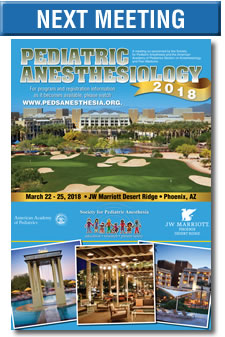American Academy of Pediatrics Section on Anesthesiology (AAP SOA)
Review of Activities
 By Rae Brown, MD, FAAP
By Rae Brown, MD, FAAP
Section Chair
It is indeed a pleasure to pen the first of what I hope will be many reviews of the activities of the Section on Anesthesiology and Pain Medicine of the American Academy of Pediatrics. The section was conceived in the early 1960’s by pediatricians and anesthesiologists that felt the need to advocate for adequate care of children in the perioperative environment. The history of the section is rich with work at the federal, state and local level. Policy statements from the AAP have formed the basis for current thinking in many areas of pediatric medicine. In recent years, the ASA and the AAP have made concerted efforts to provide clinical and administrative recommendations together consistent with the highest standard of care.
Having served on the Board of Directors of SPA, and as Chair of the Committee on Pediatric Anesthesiology of the ASA, I feel that I have come full circle in a long career of advocating for the health and safety of children. Over the next two years, and for a time afterwards, I will work with the leadership to bring SPA, SPPM, CCAS, and COPA, into the important discussion of understanding the present state of pediatric anesthesiology and pain medicine, and using conjoint resources for the good. It is critical that we make every attempt to reach consensus to the extent that we can and provide a strong single message about issues that relate to the safety of children in the perioperative period.
The Section on Anesthesiology and Pain Medicine is a dynamic group and is involved in a remarkably diverse number of decisions within the Academy. We are dedicated to the health of all children and are consistently on the lookout for like-minded professionals that want to make a difference.
Child Advocacy
This is a critical time for our specialty. The political environment threatens recent gains in federal and state child health programs, questions have been raised about the safety of the anesthetics that we provide to children, and the inappropriate use of opioids goes on seemingly unabated. At this juncture it is critical that every professional that cares for children come together to formulate the message that we cannot undercut the health or safety of the next generation of Americans. Children are the future and the American Academy of Pediatrics is the strongest voice available to speak to these issues in Washington.
Currently, the Section on Anesthesiology and Pain Medicine is collaborating with the leadership of SPA, and the directors of Smart Tots, to craft a consensus statement about the toxicity of general anesthetic agents in the developing brain. We will examine current scientific data, suggest direction for research, and propose a framework for clinicians to better understand the implications of this issue in light of the December 2016 publication of a Med Watch Warning by the FDA.
It is important at this time that we, as a profession, clarify the meaning of the information that is currently available. Our responsibility to our patients and the admonition “to do no harm”, strongly suggests that if there is any thought that a subset of our population is at risk that we understand the depth and breadth of the problem and work towards reasonable solutions.
Child Safety
In the past year, the Section on Anesthesiology has been deeply involved at the national and the state level in the pursuit of legislation to assure that sedation is provided safely for every child whether hospitalized or not. Of extreme importance has been the involvement of Rita Agarwal, MD and Charlie Cote, MD in lobbying the California legislature concerning sedation in dental offices. Currently, death and neurologic injury after failed sedation in dental offices across the nation is not consistently reported. The requirements for safety in all states do not meet the standard that it has taken so many years for anesthesiologists to develop and promulgate. Standards that provide for the safe sedation and the reporting of quality issues for all children are critical. Charlie and Rita are to be commended for their efforts.
The Section is similarly involved in an effort to reduce injury in infants and children by the ingestion of button batteries. These lithium batteries become very hot when ingested and can erode through the esophagus into the mediastinum. Deaths have occurred from mediastinitis and the Academy is working to educate parents throughout the nation about the danger of these devices.
Pediatric Drug Testing and the FDA
The AAP, through the Federal Office, the Section on Anesthesiology, and the Committee on Drugs continue to work with the Food and Drug Administration to provide for improved testing of all pharmaceuticals prior to marketing. Over the last fifty years, most medications used in children were never tested in children before marketing. In addition, specific post marketing evaluations of the behavior of drugs in large populations has not been mandated for the pediatric population. Through the use of derivative evaluations of adult testing, but not clinical trials, the Agency has attempted to provide a safe drug environment while exposing as few children to medications as possible. This has been a focus of activity for Dr. Flick and me for the last five years.
Statement Revisions
The statements regarding patient safety, the perioperative environment, pediatric pain medicine, proffered by the American Academy of pediatrics are meant to be living documents, reflecting the rapid changes in medicine. For this reason one essential job of the Section is to continuously evaluate what has been written and determine its applicability to the current state. At present, the Section is crafting a Policy Statement concerning the provision of chronic pain for children as well as finishing a major revision of the Academy’s acute pain statement. We are also collaborating with other sections on revisions of statements concerning sedation for children undergoing dental care and sedation management for children undergoing procedures in the ED.
In addition, Dr. Joe Tobias is leading a group that is examining the use of oxymetazoline in the operating room with the Section on Otolaryngology. After a period of review this will be written up as a clinical statement to be published in Pediatrics.
Coincident with this work, the Section has presented an intent statement to the Board of Directors for a manual on Pediatric Airway Management to be published following the successful publication of the manual on Procedural Sedation for Infants and Children released in July of 2016.
In addition to all of these offerings, the Section, in conjunction with the Committee on Substance Use and Prevention, has proposed a six article series in Pediatric News about opioid abuse and the role that substance abuse plays in child health.
Education
The Section will have presentations at the 2018 National Conference and Exposition in Orlando in conjunction with the Committee on Critical Care. Of special note is that a proposal by Dr. Rita Agarwal; former Chair of the Section, to the AAP has resulted in a major daylong presentation on the impact of opioids on the Child. This will be presented the day prior to the beginning of the NCE, and will incorporate presentations from many areas within the Academy including surgery, substance abuse, and critical care. This will be an opportunity to showcase the significant work done by the section over the last five years.
The Section on Anesthesiology and Pain Medicine occupies a unique position in medicine. The close affiliation with AAP invites the opportunity to expand our profession and to educate our pediatric colleagues about the perioperative arena. My work with the FDA has taught me that the Academy is well thought of in our nation’s capital giving us, occasionally, an opportunity to be involved with fundamental changes in the health of our children. For the health care provider, what better way to find fulfillment in one’s profession than to be involved in improving the lives of children throughout the U.S? Join US!






